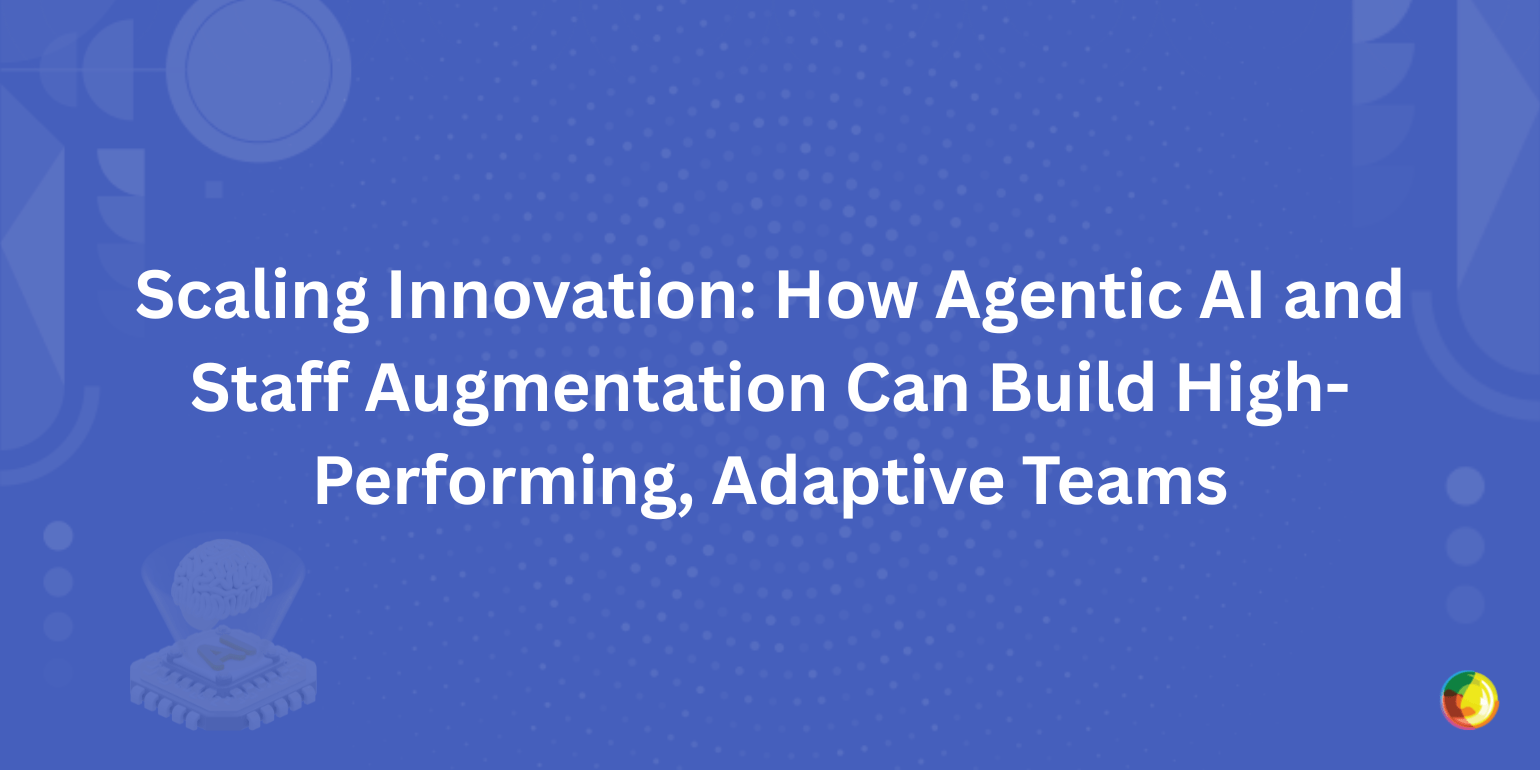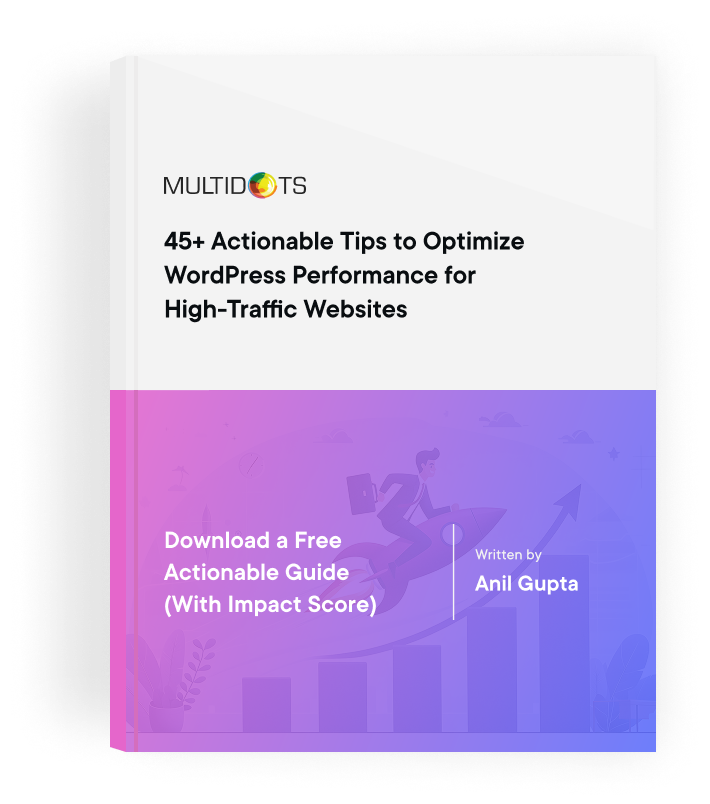Scaling Innovation: How Agentic AI and Staff Augmentation Can Build High-Performing, Adaptive Teams
Discover how forward-thinking enterprises are transforming their innovation strategies by combining agentic AI and staff augmentation.

Table of Contents
Picture this: It's 3 AM, and your lead developer just discovered a critical bug that could derail tomorrow's product launch. Your team has been stretched thin for months, and hiring the specialized talent you need would take another six weeks, time you simply don't have.
Now imagine a different scenario: Your AI agents detected the potential issue three days ago, automatically ran diagnostics, and flagged it for your augmented development team—world-class experts who integrated seamlessly with your processes and resolved the problem before it escalated.
This isn't wishful thinking. It's the reality for enterprises that have cracked the code on scaling innovation.
With widespread skills gaps across industries and markets evolving at breakneck speed, traditional approaches to innovation are failing. The enterprises that thrive aren't just throwing more resources at problems—they're fundamentally reimagining how teams operate by combining the power of agentic AI with the strategic flexibility of staff augmentation to create something extraordinary: teams that innovate faster, adapt quicker, and deliver results that seemed impossible just years ago.
What Does It Mean to "Scale Innovation" Today?
Scaling innovation goes far beyond having a few brilliant minds in a room brainstorming the next big idea. It's about creating systems, processes, and teams that can consistently deliver breakthrough solutions at speed and scale. It means operationalizing creativity, experimentation, and problem-solving across an entire organization without sacrificing quality or momentum.
Think about it this way: traditional innovation operates like a craftsman's workshop, with highly skilled individuals creating bespoke solutions one at a time. Scaled innovation, on the other hand, functions like a modern manufacturing plant, leveraging systems, automation, and specialized expertise to produce exceptional results consistently and efficiently.
This shift isn't just nice-to-have; it's survival-critical. Markets move faster than ever, customer expectations evolve daily, and competitive advantages that once lasted years now disappear in months. Organizations that can't innovate at scale find themselves perpetually playing catch-up.
Two Catalysts Driving This Transformation
We're seeing two powerful forces reshape how enterprises approach innovation:
Agentic AI represents a fundamental evolution in artificial intelligence. Unlike traditional AI based on large language models that waits for commands, agentic AI systems act independently, making decisions, executing tasks, and providing insights autonomously. These systems don't just process data—they understand context, anticipate needs, and take action to solve problems before they escalate.
Staff Augmentation offers a strategic approach to talent that prioritizes flexibility and expertise over traditional employment models. Rather than being locked into lengthy hiring processes or permanent headcount, enterprises can inject specialized skills precisely when and where they're needed most.
The breakthrough insight? When you combine the rapid adaptability of agentic AI with the strategic flexibility of staff augmentation, you create something extraordinary: teams that can pivot quickly, execute flawlessly, and deliver results that would have been impossible just a few years ago.
The Innovation Bottlenecks Holding Enterprises Back
Despite significant investments in technology and talent, most enterprises struggle with four critical challenges that limit their innovation potential:
1. Talent Gaps That Never Close
The demand for specialized skills, particularly in AI, advanced development, UX design, and digital strategy, far outpaces supply. According to recent industry reports, 87% of companies report difficulty finding qualified candidates for critical technical roles. Even when they do find talent, the hiring process can take months, during which projects stall and opportunities slip away.
At Multidots, we've seen enterprises with massive budgets struggle to find the right WordPress developers, performance optimization experts, or migration specialists. These aren't entry-level positions, they require deep expertise that takes years to develop and is constantly evolving with new technologies and best practices.
2. Process Bottlenecks That Multiply Delays
Traditional project management approaches create friction at every step. Manual coordination between teams, fragmented communication across tools, and legacy approval processes turn what should be streamlined workflows into obstacle courses.
We've audited enterprise workflows where a simple content update requires approval from six different stakeholders across three different tools, a process that can take weeks for changes that should happen in hours.
3. The Relentless Pace of Change
Markets don't wait for organizations to catch up. Customer preferences shift overnight, new technologies emerge monthly, and competitive landscapes transform quarterly. Rigid team structures and inflexible systems can't adapt quickly enough.
Organizations with annual planning cycles find themselves executing strategies that were relevant when they were created but obsolete by the time they're implemented.
4. The Misalignment Tax
Perhaps most costly of all is the misalignment that occurs when feedback is vague, requirements are unclear, and vision isn't shared across teams.
We've seen projects where "make it more engaging" gets interpreted differently by design, development, and marketing teams, leading to multiple rounds of revisions that could have been avoided with clearer communication from the start.
How Agentic AI Transforms Innovation Workflows
Agentic AI represents a paradigm shift in how teams operate. Instead of AI being a tool that humans use, it becomes an intelligent participant in the workflow—understanding context, making decisions, and taking action autonomously.
Autonomous Task Execution at Scale
Modern agentic AI systems can handle complex, multi-step processes without human intervention. Take quality assurance, for example. Traditional QA processes require human testers to manually check hundreds of elements across different devices and browsers—a process that can take days or weeks.
Platforms like Atarim are pioneering this transformation with AI agents that can perform thousands of automated checks in minutes, identifying issues that human testers might miss while documenting everything with pixel-perfect precision. Atarim's AI agents (Pixel, Lexi, Navi, etc.) including specialized agents for different functions, handle everything from QA to SEO to UX review, reducing delivery times by up to 70%.
We've implemented similar automation principles for our enterprise clients' WordPress migrations. AI-driven analysis can review source code, identify potential conflicts, suggest optimizations, and even execute certain migration tasks autonomously, reducing what used to be months-long projects to weeks.
Real-Time, Contextual Intelligence
Unlike traditional software that operates in isolation, integrating agentic AI works within the context of actual workflows. It sees what team members see, understands the current state of projects, and provides relevant insights exactly when they're needed. This contextual awareness means AI can offer suggestions that are immediately actionable rather than generic recommendations that require interpretation.
Atarim's approach exemplifies this perfectly—their AI agents operate directly within the workflow, seeing what users see, understanding code context, and offering suggestions without requiring teams to jump between multiple tools. This real-time, contextual collaboration eliminates the back-and-forth clarification cycles that often delay projects.
For instance, when reviewing a website's performance, an AI agent doesn't just report that page load times are slow—it identifies specific images that need optimization, suggests code improvements, and even predicts how these changes will impact user experience metrics.
Precision and Consistency
Human experts are brilliant but inconsistent. Energy levels fluctuate, attention varies, and even the most skilled professionals can miss details when handling repetitive tasks.
Agentic AI maintains the same high standard across every interaction, every analysis, and every recommendation. This consistency becomes particularly valuable when scaling operations across multiple projects or teams.
Breaking Down Communication Barriers
One of the most powerful applications of agentic AI is its ability to translate between different perspectives and technical levels.
When a stakeholder provides feedback like "make the design more professional," AI can interpret this vague directive and convert it into specific, actionable tasks for designers and developers. This translation capability eliminates the back-and-forth clarification cycles that often delay projects.
The Strategic Power of Staff Augmentation
While agentic AI handles process automation and optimization, staff augmentation addresses the human expertise gap with surgical precision.
Access to World-Class Talent On-Demand
Staff augmentation allows enterprises to access expertise that would be impossible to maintain internally. Instead of hiring full-time specialists for every potential need, companies can bring in experts precisely when their skills are required. This approach is particularly powerful for specialized areas like WordPress enterprise development, where the depth of expertise required may only be needed for specific projects.
At Multidots, we've helped enterprises access our years of WordPress expertise without requiring them to build internal teams with the same level of specialization. This model allows enterprises to benefit from world-class capabilities while maintaining flexibility in their staffing approach.
Cost-Efficient Scaling Without Overhead
Traditional hiring comes with significant overhead—recruitment costs, benefits, office space, training, and the risk of mismatched skills. Staff augmentation eliminates most of these concerns. Organizations pay for expertise when they need it, scale up for large projects, and scale down when priorities shift. This efficiency becomes particularly important for innovation initiatives where requirements may evolve rapidly.
Knowledge Diversity That Sparks Innovation
External specialists bring perspectives that internal teams may lack. They've solved similar problems for other organizations, understand industry best practices, and can challenge internal assumptions that may be limiting innovation. This diversity of thought often leads to breakthrough solutions that wouldn't emerge from internal teams alone.
Accelerated Time to Market
Perhaps most importantly, staff augmentation dramatically reduces time to value. Expert teams can begin contributing immediately, without the ramp-up time required for new hires. For innovation projects where speed to market can determine success or failure, this acceleration is invaluable.
The Synergy: Where Artificial Intelligence Meets Augmented Teams
The real magic happens when agentic AI and staff augmentation work together, creating capabilities that neither could achieve alone.
Cognitive Load Reduction
When AI handles routine analysis, monitoring, and coordination tasks, human experts can focus entirely on high-value activities like strategy, creative problem-solving, and innovation. This isn't about replacing human intelligence, it's about amplifying it by removing friction and cognitive overhead.
Imagine a website migration project where AI agents continuously monitor performance metrics, flag potential issues, and suggest optimizations, while human migration experts focus on strategic decisions and complex problem-solving. The result is faster delivery with higher quality outcomes.
Hybrid Workflows That Accelerate Innovation
The combination enables entirely new types of workflows. AI can analyze market trends and user behavior patterns while augmented design teams create prototypes based on these insights. Development teams can iterate on these prototypes while AI continuously tests and validates changes. What previously required sequential phases can now happen in parallel, dramatically reducing innovation cycles.
Dynamic Adaptability
Perhaps most importantly, this combination creates teams that can adapt in real-time. As project requirements change, AI systems can immediately adjust their analysis and recommendations while augmented staff can pivot their focus to new priorities. This adaptability is crucial for innovation projects where the goal posts often move as teams learn and discover new opportunities.
Quality Multiplication
When expert human judgment combines with AI's comprehensive analysis capabilities, the result is quality that exceeds what either could achieve independently. Human experts provide context, creativity, and strategic thinking, while AI ensures comprehensive coverage, consistency, and objective analysis.
Proof of Concept in Action
The combination of AI and expert human teams isn't theoretical, it's delivering measurable results today. Companies leveraging advanced collaboration platforms like Atarim alongside strategic staff augmentation are seeing dramatic improvements in both speed and quality. Organizations have reported significant improvements in delivery times and team satisfaction when AI agents handle routine coordination while human experts focus on strategic problem-solving.
The Path Forward: Your Innovation Transformation Starts Now
Combining agentic AI with staff augmentation offers a powerful way to scale innovation, boosting speed, adaptability, and quality simultaneously.
The opportunity to build high-performing, adaptive teams is available now, but it requires intentional action:
Next Steps:
- Identify friction-heavy workflows where AI could help
- Start with a pilot team using agentic tools like Atarim
- Explore trusted staff augmentation partners for skill gaps
- Invest in AI literacy across roles to future-proof your organization
The opportunity is now: Enterprises that learn to balance automation with augmentation will define the next generation of market leaders. The question isn't whether this transformation will happen, but whether your organization will lead it or struggle to catch up.
At Multidots, we've spent over 15 years helping enterprises navigate complex technological transformations. Whether you're looking to implement advanced WordPress solutions, optimize your digital infrastructure, or explore how AI can enhance your development workflows, we understand the strategic and technical challenges involved in scaling innovation.
The future belongs to enterprises that can innovate at scale. The tools and strategies to make this happen are available today. The only question is: will you use them?
Feel free to schedule a quick call with our team.
Contact Us
